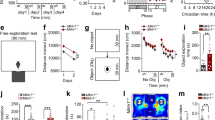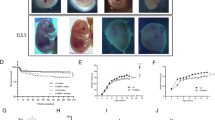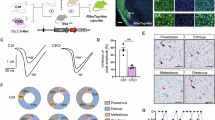Abstract
CCK2 receptor-deficient mice were used to investigate in vivo the role of this receptor in behavior. Mutant mice showed a neuromuscular impairment in the traction and rotarod tests but not in the chimney test. Brain cholecystokinin has been shown to participate in stress-related behaviors. However, CCK2 receptor-deficient mice did not show behavioral modifications compared to wild-type mice in the elevated plus maze and in the motility conditioned suppression test, indicating that compensatory mechanisms very likely occur following CCK2 receptor invalidation. On the other hand, a hyperlocomotor activity was observed in actimeter which can be related to an impairment in environmental habituation. Finally, CCK2 receptor-deficient mice showed an impairment of performance in the spontaneous alternation behavior as expected from the opposite effects evoked by CCK2 agonists, supporting the physiological role of CCK2 receptors in attention and/or memory processes. This result is reinforced by the defects observed in these functions after the administration of CCK2 antagonists.
Similar content being viewed by others
Log in or create a free account to read this content
Gain free access to this article, as well as selected content from this journal and more on nature.com
or
References
Anisman H, Kokkinidis L . (1975): Effects of scopolamine, D-amphetamine and other drugs affecting catecholamines on spontaneous alternation and locomotor activity in mice. Psychopharmacologia 45: 55–63
Bock MG, Dipardo RM, Evans BE, Rittle KE, Whitter WL, Veber DF, Anderson PS, Freidinger RM . (1989): Benzodiazepine gastrin and brain cholecystokinin receptor ligands : L365,260. J Med Chem 32: 13–16
Boissier JR, Tardy J, Diverres JC . (1960): Une nouvelle méthode simple pour explorer l'action “tranquillisante”: le test de la cheminée. Med Experimentalis 3: 81–84
Charpentier B, Durieux C, Pélaprat D, Dor A, Reibaud M, Blanchard J-C, Roques BP . (1988): Enzyme-resistant CCK analogues with high selectivity for central receptors. Peptides 9: 835–841
Courvoisier S . (1956): Pharmacodynamic basis for the use of chlorpromazine in psychiatry. J Clin Exp Psychopath 17: 25–37
Crawley JN, Corwin RL . (1994): Biological actions of cholecystokinin. Peptides 15: 731–755
Crawley JN . (1999): Behavioral phenotyping of transgenic and knockout mice: experimental design and evaluation of general health, sensory functions, motor abilities, and specific behavioral tests. Brain Res 835: 18–26
Daugé V, Dor A, Féger J, Roques BP . (1989): The behavioral effects of the CCK8 injected into the medial nucleus accumbens are dependent on the motivational states of the rats. Eur J Pharmacol 163: 25–32
Daugé V, Roques BP . (1995): Reward and anxiety: The opposite pharmacology of opioids and CCK. In Bradwejn J, Vasar E (eds), Cholecystokinin and Anxiety, from Neuron to Behavior. Georgetown, Texas, RG Landes Company, pp 161–171
Daugé V, Corringer P-J, Roques BP . (1995): CCKA, but not CCKB agonists suppress the hyperlocomotion induced by endogenous enkephalins, protected from enzymatic degradation by systemic RB101. Pharmacol Biochem Behav 50: 133–139
Daugé V, Léna I . (1998): CCK in anxiety and cognitive processes. Neurosci Biobehav Rev 22: 815–825
Derrien M, Noble F, Maldonado R, Roques BP . (1993): CCKA or CCKB receptors activation lead to antinociception and to hyperalgesia respectively: evidence for an indirect interaction with the opioidergic system. Neurosci Lett 160: 193–196
Derrien M, McCort-Tranchepain I, Ducos B, Roques BP, Durieux C . (1994): Heterogeneity of CCKB receptors involved in animal models of anxiety. Pharmacol Biochem Behav 49: 133–141
Dockray GJ . (1976): Immunochemical evidence of cholecystokinin-like peptides in brain. Nature 264: 568–570
Dunham NW, Miya TS . (1957): Note on a simple apparatus for detecting neurological deficit in rats and mice. J Am Pharm Ass 46: 208–214
Durieux C, Coppey M, Zajac JM, Roques BP . (1986): Occurrence of two cholecystokinin binding sites in guinea pig brain cortex. Biochem Biophy Res Commun 137: 1167–1173
Gaudreau P, Quirion R, Saint-Pierre S, Pert CB . (1983): Characterization and visualization of cholecystokinin receptors in the rat brain using (3H)-pentagastrin. Peptides 4: 755–762
Gerlai R . (1996): Gene-targeting studies of mammalian behavior: is it the mutation or the background genotype. TINS 19: 177–182
Harper EA, Shankley NP, Black JW . (1999a): Characterization of the binding of a novel radioligand to CCKB/gastrin receptors in membranes from rat cerebral cortex. Brit J Pharmacol 126: 1504–1512
Harper EA, Griffin EP, Shankley NP, Black JW . (1999b): Analysis of the behaviour of selected CCKB/gastrin receptor antagonists in radioligand binding assays performed in mouse and rat cerebral cortex. Brit J Pharmacol 126: 1496–1503
Harro J, Vasar E, Bradwejn J . (1993): CCK in animal and human, research on anxiety. Trends Pharmacol Sci 14: 244–249
Hill DR, Campbell NJ, Shaw TM, Woodruff GM . (1987): Autoradiographic localization and biochemical characterization of peripheral type CCK receptors in rat CNS using highly selective nonpeptide CCK antagonists. J Neurosci 7: 2967–2976
Jung HH, Lauterbur TH, Burgunder JM . (1997): Expression of neurotransmitter genes in rat spinal motoneurons after chemodenervation with botulinum toxin. Neuroscience 78: 469–479
Kameyama T, Nagasaka M . (1982): Effects of apomorphine and diazepam on a quickly learned conditioned suppression in rats. Pharmacol Biochem Behav 17: 59–63
Kelly MA, Rubinstein M, Phillips TJ, Lessov CN, Burkhart-Kasch S, Zhang GE, Bunzow JR, Fang Y, Gerhardt GA, Grandy DK, Low MJ . (1998): Locomotor activity in D2 dopamine receptor-deficient mice is determined by gene dosage, genetic background, and developmental adaptations. J Neurosci 18: 3470–3479
Kieffer B . (1999): Opioids: first lessons from knockout mice. TiPS 20: 19–25
Ladurelle N, Roques BP, Daugé V . (1995): The transfer of rats from a familiar to a novel environment prolongs the increase of extracellular dopamine efflux induced by CCK8 in the posterior nucleus accumbens. J Neurosci 15: 3118–3127
Ladurelle N, Keller G, Blommaert A, Roques BP, Daugé V . (1997): The CCKB agonist, BC264, increases dopamine in the nucleus accumbens and facilitates motivation and attention after intraperitoneal injection in rats. Eur J Neurosci 9: 1804–1814
Lee YM, Beinborn M, McBride EW, Lu M, Kolakowski LF, Kopin AS Jr . (1993): The human brain cholecystokinin-B/gastrin receptor. J Biol Chem 268: 8164–8169
Léna I, Simon H, Roques BP, Daugé V . (1999): Opposing effects of two CCKB agonists on the retrieval phase of a two-trial recognition task after systemic injection in the rat. Neuropharmacol 38: 543–553
Miyasaka K, Shinozaki H, Suzuki S, Sato Y, Kanai S, Masuda M, Jimi A, Nagata A, Matsui T, Noda A, Kono A, Funakoshi A . (1999): Disruption of cholecystokinin (CCK)-B receptor gene did not modify bile or pancreatic secretion or pancreatic growth: A study in CCKB receptor gene knockout mice. Pancreas 19: 114–118
Mogil T, Grisel JL . (1998): Transgenic studies of pain. Pain 77: 107–128
Moran TH, Robinson PH, Goldrich MS, McHungh PR . (1986): Two brain cholecystokinin receptors: Implications for behavioral actions. Brain Res 362: 175–179
Nagata A, Mitsuhiro I, Iwata N, Kuno J, Takano H, Miniwa O, Chihara K, Matsui T, Noda T . (1996): G protein-coupled cholecystokinin-B/gastrin receptors are responsible for physiological cell growth of the stomach mucosa in vivo. Proc Natl Acad Sci USA 93: 11825–11830
Noble F, Stephen AW, Crawley JN, Bradwejn J, Seroogy KB, Hamon M, Roques BP . (1999): International Union of Pharmacology. XXI. Structure, Distribution, and Functions of Cholecystokinin Receptors. Pharmacol Rev 51: 745–781
Pélaprat D, Broer Y, Studler JM, Peschanski M, Tassin JP, Glowinski J, Rostenes W, Roques BP . (1987): Autoradiography of CCK receptors in the rat brain using (3H)-Boc(Nle28,31)CCK27-33 and (125I) Bolton-Hunter CCK8. Functional significance of subregional distributions. Neurochem Int 10: 495–508
Pélaprat D, Dusart I, Peschanski M . (1988): Postnatal development of cholecystokinin (CCK) binding sites in the rat forebrain and midbrain: an autoradiographic study. Developmental Brain Res 44: 119–132
Pellow S, Chopin P, File SE, Briley M . (1985): Validation of open/closed arm entries in an elevated plus-maze as a measure of anxiety in the rat. J Neurosci Methods 14: 149–167
Pommier B, Da Nascimento S, Dumont S, Bellier B, Million E, Garbay C, Roques BP, Noble F . (1999): The cholecystokinin B receptor is coupled to two effector pathways through pertussis toxin-sensitive and –insensitive G proteins. J Neurochem 73: 281–288
Rataud J, Darche F, Piot O, Stutzmann JM, Böhme GA, Blanchard JC . (1991): Anxiolytic effect of CCK-antagonists on plus-maze behavior in mice. Brain Res 548: 315–317
Sebret A, Léna I, Crété D, Matsui T, Roques BP, Daugé V . (1999): Rat hippocampal neurons are critically involved in physiological improvement of memory processes induced by cholecystokinin-B receptor stimulation. J Neurosci 15: 7230–7237
Sekiguchi R, Moroji T . (1986): A comparative study on characterization and distribution of cholecystokinin binding sites among the rat, mouse and guinea-pig brain. Brain Res 399: 271–281
Shlik J, Vasar E, Bradwejn J . (1997): Cholecystokinin and psychiatric disorders. CNS Drugs 8: 134–152
Singh L, Field MJ, Hughes J, Menzies R, Oles RJ, Vass CA, Woodruff GN . (1991): The behavioral properties of CI-988, a selective cholecystokinin B receptor antagonist. Brit J Pharmacol 104: 239–245
Smadja C, Maldonado R, Turcaud S, Fournié-Zaluski MC, Roques BP . (1995): Opposite role of CCKA and CCKB receptors in the modulation of endogenous enkephalin antidepressant-like effects. Psychopharmacol 120: 400–408
Vanderhaeghen JJ . (1975): New peptide in the vertebrate CNS reacting with antigastrin antibodies. Nature 257: 604–605
Wank SA, Pisegna JR, De Weerth A . (1992): Brain and gastrointestinal cholecystokinin receptor family: Structure and functional expression. Proc Natl Acad Sci USA 89: 8691–8695
Acknowledgements
We thank H. Dhôtel for the synthesis of BC264.
Author information
Authors and Affiliations
Corresponding author
Rights and permissions
About this article
Cite this article
Daugé, V., Sebret, A., Beslot, F. et al. Behavioral Profile of CCK2 Receptor-deficient Mice. Neuropsychopharmacol 25, 690–698 (2001). https://doi.org/10.1016/S0893-133X(01)00291-3
Received:
Revised:
Accepted:
Published:
Issue date:
DOI: https://doi.org/10.1016/S0893-133X(01)00291-3
Keywords
This article is cited by
-
Sex-specific phenotypes of hyperthyroidism and hypothyroidism in aged mice
Biology of Sex Differences (2017)
-
Sex-specific phenotypes of hyperthyroidism and hypothyroidism in mice
Biology of Sex Differences (2016)
-
Cholecystokinin receptor-1 mediates the inhibitory effects of exogenous cholecystokinin octapeptide on cellular morphine dependence
BMC Neuroscience (2012)
-
Cholecystokinin type B receptor
AfCS-Nature Molecule Pages (2010)
-
Wiring and Volume Transmission in Rat Amygdala. Implications for Fear and Anxiety
Neurochemical Research (2008)



